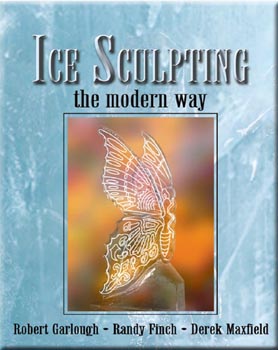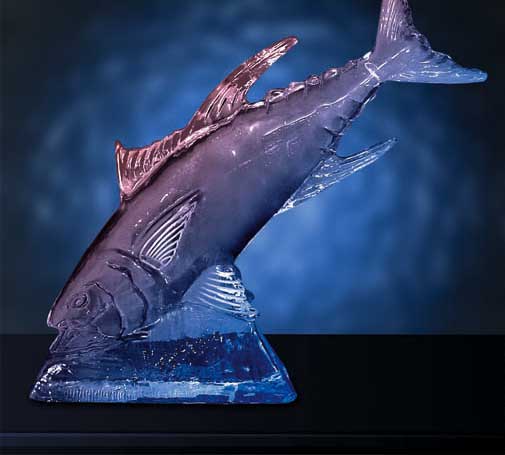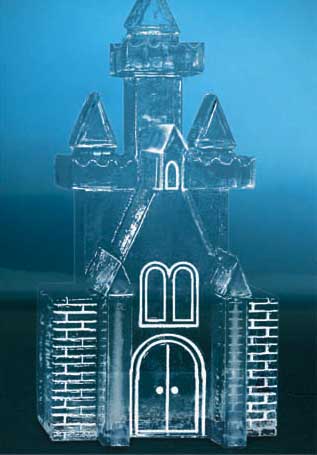

 As a
carving material, wood ranks well behind
metal and stone in terms of permanence. Wood can deteriorate,
rot or burn, which leaves occasional gaps in the historical record
of wood carving. But as short-lived as a wood carving sometimes
is, consider the highly ephemeral nature of an ICE carving, whose
life is measured in terms of hours, not years.
As a
carving material, wood ranks well behind
metal and stone in terms of permanence. Wood can deteriorate,
rot or burn, which leaves occasional gaps in the historical record
of wood carving. But as short-lived as a wood carving sometimes
is, consider the highly ephemeral nature of an ICE carving, whose
life is measured in terms of hours, not years.
This centuries old art form is currently making a transition from the 18th century to modern times, from Japanese-made hand chisels to electrical and pneumatic saws and grinders.
Long practiced in this country as an adjunct to the culinary arts, ice carving is perhaps finally coming of age as an art in and of itself. As partial witness, consider the many formal ice carving competitions that now take place every year.
Another indication of this coming of age is the publication of books such as Ice Sculpting the Modern Way. Covering a wide range of topics from understanding ice and design to setting up a studio and running a business, it is equally at home in a junior college classroom or a carving shop.
 Ice Sculpting was written by three professional
chefs with many years of ice sculpting experience.
Ice Sculpting was written by three professional
chefs with many years of ice sculpting experience.
Robert Garlough is Chef Emeritus of Grand Rapids Community College, where he taught for more than twenty-five years.
Randy Finch has over twenty years experience in the food service industry and in 1994 co-founded Ice Sculptures, Ltd, in Grand Rapids, MI
Derek Maxfield began his culinary career in the late '80's and co-found Ice Sculptures, Ltd with Randy Finch.
Ice Sculptures, Ltd is based, appropriately enough, in a former ice factory on the west side of Grand Rapids, MI. Finch and Maxfield and their crew have won a number of ice carving competitions and have appeared on Ripley's Believe It or Not. (See the companion article in this issue of WOM, or the Ice Sculpture, Ltd. web page HERE
Chapters in this book include:
Part I Learning About Sculpting In Ice
Chapter 1 The Art of Sculpting
Chapter 2 Understanding the Medium - The Science of Ice
Chapter 3 The Sculptor's Tools and Equipment
Chapter 4 Safe Practices and Procedures
Part II Working With Ice
Chapter 5 Mastering Shapes and Form
Chapter 6 Sculpting with Templates
Chapter 7 Fusing: and Joining Ice To Ice
Part III Managing The Ice
Chapter 8 The Studio
Chapter 9 Methods of Transportation
Chapter 10 Displaying and Lighting for Effect
Part IV Advances Stills With Ice
Chapter 11 Custom Design Techniques
& Special Event Sculpting
Chapter 12 Ice Sculpting Organizations, Competitions and Festivals
Chapter 13 The Business Side Of Ice Sculpting
Appendices
Appendix A Beginning Sculptures
Appendix B Intermediate Sculptures
Appendix C Advanced Sculptures
Appendix D Additional Templates
Appendix E Resources and References
Glossary
 Commentary
Commentary
At over 364 pages, this book is not your average carving book; it is as much classroom text book as "how-to" instructional guide. The chapters in the first half of the book are set up text book style and will undoubtedly find wide use in the classroom. It would also be a useful book for someone wanting to be become a better ice sculptor on their own. The information is well written and easy to understand.
The Appendices take up fully half the book, with 16 color plates and many black and white photos, including step-by-step photos for each project. This half of the book is pretty much all patterns, projects and photos, with a good selection of beginner to advance projects. If you want to try ice sculpture, this is the meat-and-potatoes of the book.
So is this a book that will be on every carver's shelf? Well, likely not. At pricing ranging from $40 to $45, it's more than some carvers would be willing to pay.
On the other hand, if you are truely interesting in giving ice carving a shot (and more woodcarvers should), then you would find the $40 money well spent.
Not sure yet if you would like to try ice carving? Start checking the web for information about up coming ice carving competitions and plan on paying a visit. You just might find yourself hooked on a cool variety of carving!